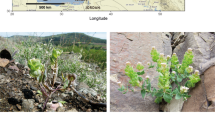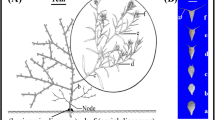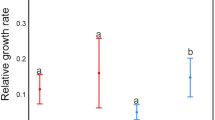Abstract
Phenotypic plasticity in species with heteromorphic diaspores is considered to be a plastic bet-hedging strategy in environmentally fluctuating habitats. The primary aim of this study was to determine the influence of level of abiotic (soil moisture and nutrient availability) and biotic (pure and mixed density) factors on the long-glochid (LN; high dispersal, low dormancy)/short-glochid (SN; low dispersal, high dormancy) nutlet ratio and on nutlet combination of the fruit-dimorphic cold desert winter annual/spring ephemeral Lappula duplicicarpa derived from different nutlet morphs. We hypothesized that stress would decrease the LN: SN ratio. All levels of the four treatments resulted in significant variation in the LN: SN ratio and in the proportion of each nutlet combination. Reproductive biomass varied less than plant mass in plants from both morphs. In favorable environments, the LN: SN ratio and number of SN–3LN and 4LN combinations were relatively high, while in unfavorable environments they were relatively low, thus supporting our hypothesis. Relative allocation to reproductive biomass was significantly negatively correlated with allocation to vegetative biomass. The downward shift that occurred in the LN: SN diaspore ratio in response to stressful growth conditions in Lappula duplicicarpa is assumed to be a bet-hedging strategy.





Similar content being viewed by others
References
Abudureheman B, Yan C, Liu YF, Wei Y (2012) Seed size, germination characteristics, and seed production of Borsczowia aralocaspica in different growth years. Chin J Ecol 31:844–849 (in Chinese with English abstract)
Baker GA, O’Dowd DJ (1982) Effects of parent plant density on the production of achene types in the annual Hypochoeris glabra. J Ecol 70:201–215
Beneke K, Van Rooyen MW, Theron GK (1993) Fruit polymorphism in ephemeral species of Namaqualand. IV. Growth analysis of plants cultivated from dimorphic diaspores. J Arid Environ 24:345–360
Brändel M (2007) Ecology of achene dimorphism in Leontodon saxatilis. Ann Bot 100:1189–1197
Cheplick GP (1994) Life history evolution in amphicarpic plants. Plant Spec Biol 9:119–131
Cheplick GP (2007) Plasticity in chasmogamous and cleistogamous reproductive allocation in grasses. Aliso 23:286–294
Clauss MJ, Venable DL (2000) Seed germination in desert annuals: an empirical test of adaptive bet hedging. Am Nat 155:168–186
de Wit CT (1960) On competition. Versl Landbouwk Onderz 66:1–82
Diaz A, McNair MR (1998) The effect of plant size on expression of cleistogamy in Mimulus nasutus. Funct Ecol 12:92–98
Ellison AM (1987) Effect of seed dimorphism on the density-dependent dynamics of experimental populations of Atriplex triangularis (Chenopodiaceae). Am J Bot 74:1280–1288
Gardocki ME, Zablocki HI, El-Keblawy A, Freeman DC (2000) Heterocarpy in Calendula micrantha (Asteraceae): the effects of competition and availability of water on the performance of offspring from different fruit morphs. Evol Ecol Res 2:701–718
Harper JL (1977) Population biology of plants. Academic Press, London
Harper JL, Lovell PH, Moore KG (1970) The shapes and sizes of seeds. Annu Rev Ecol Syst 1:327–356
Imbert E (2002) Ecological consequences and ontogeny of seed heteromorphism. Perspect Plant Ecol Evol Syst 5:13–36
Langer RHM, Wilson D (1965) Environmental control of cleistogamy in the prairie grass (Bromus unioloides H.B.K.). New Phytol 64:80–85
Lu JJ, Tan DY, Baskin JM, Baskin CC (2012) Phenotypic plasticity and bet-hedgining in a heterocarpic winter annual/spring ephemeral cold desert species of Brassicaceae. Oikos 121:357–366
Ma WB, Zhao XJ, Tan DY, Baskin CC, Baskin JM, Xue JH (2010) Nutlet dimorphism in individual flowers of two cold desert annual Lappula species (Boraginaceae): implications for escape by offspring in time and space. Plant Ecol 209:361–374
Mandák B (1997) Seed heteromorphism and the life cycle of plants: a literature review. Preslia 69:129–159
Mandák B, Pyšek P (1999) Effects of plant density and nutrient levels on fruit polymorphism in Atriplex sagittata. Oecologia 119:63–72
Mandák B, Pyšek P (2005) How does seed heteromorphism influence the life history stages of Atriplex sagittata (Chenopodiaceae)? Flora 200:516–526
Mao ZM, Zhang DM (1994) The conspectus of ephemeral flora in northern Xinjiang. Arid Zone Res 11:1–26 (in Chinese with English abstract)
Rai JPN, Tripathi RS (1987) Germination and plant survival and growth of Galinsoga parviflora Cav. Acta Oecol 8:155–165
Roach DA, Wulff RD (1987) Maternal effects in plants. Annu Rev Ecol Syst 18:209–235
Ruiz de Clavijo E (1994) Heterocarpy and seed polymorphism in Ceratocapnos heterocarpa (Fumariaceae). Int J Plant Sci 152:196–202
Ruiz de Clavijo E, Jiménez MJ (1998) The influence of achene type and plant density on growth and mass allocation of the heterocarpic annual Catananche lutea (Asteraceae). Int J Plant Sci 159:637–647
Sadeh A, Guterman H, Gersani M, Ovadia O (2009) Plastic bet-hedging in an amphicarpic annual: an integrated strategy under variable conditions. Evol Ecol 23:373–388
Schmid B, Dolt C (1994) Effect of maternal and paternal environment and genotype on offspring phenotype in Solidago altissima L. Evolution 48:1525–1549
Sokal RR, Rohlf FJ (1995) Biometry: the principles and practice of statistics in biological research, 3rd edn. Freeman, San Francisco
Talavera M, Arista M, Ortiz PL (2012) Evolution of dispersal traits in a biogeographical context: a study using the heterocarpic Rumex bucephalophorus as a model. J Ecol 100:1194–1203
Ungar IA (1984) Autecological studies with Atriplex triangularis Willdenow. In: Tiedemann AS et al. (compilers) Proceedings—symposium on the biology of Atriplex and related chenopods; 1983 May 2–6; Provo, UT. Gen Tech Rep INT-172. Odgen, UT: U.S. Dept Agric, For Serv Intermountain Forest and Range Experiment Station, pp 40–52
Venable DL (1985a) Ecology of achene dimorphism in Heterotheca latifolia. III. Consequences of varied water availability. J Ecol 73:757–763
Venable DL (1985b) The evolutionary ecology of seed heteromorphism. Am Nat 126:577–595
Venable DL, Levin DA (1985a) Ecology of achene dimorphism in Heterotheca latifolia. I. Achene structure, germination and dispersal. J Ecol 73:133–145
Venable DL, Levin DA (1985b) Ecology of achene dimorphism in Heterotheca latifolia. II. Demographic variation within populations. J Ecol 73:743–755
Venable DL, Burquez A, Corral G, Morales E, Espinosa F (1987) The ecology of seed heteromorphism in Heterosperma pinnatum in central Mexico. Ecology 68:65–76
Venable DL, Dyreson E, Morales E (1995) Population dynamic consequences and evolution of seed traits of Heterosperma pinnatum (Asteraceae). Am J Bot 82:410–420
Venable DL, Dyreson E, Piñero D, Becerra JX (1998) Seed morphometrics and adaptive geographic differentiation. Evolution 52:344–354
Wang HF, Wei Y (2007) Seed polymorphism and fruit-set patterns of Salsola affinis. Biodivers Sci 15:419–424 (in Chinese with English abstract)
Wang WC, Liu YL, Zhu GL, Lian YSh, Wang JQ, Wang QR (1989) Lappula V. Wolf. In: Kong XW, Wang WC (eds) Flora Reipublicae Popularis Sinicae, vol 64. Science Press, Beijing, pp 177–207 (in Chinese)
Wei Y, Yan C, Yin LK (2003) Seed polymorphism and ecotype of Atriplex aucheri. Acta Bot Boreal-Occid Sin 23:485–487 (in Chinese with English abstract)
Wei Y, Wang HF, An SZ (2008) Study on fruit polymorphism and size-dependent reproductive output of Salsola bracchita. Arid Zone Res 25:357–362 (in Chinese with English abstract)
Wenny DG (2001) Advantages of seed dispersal: a reevaluation of directed dispersal. Evol Ecol Res 3:51–74
Zhao XJ, Tan DY, Li XR (2008) The breeding system of two ephemeral species of Lappula, with reference to their adaptations to the Junggar Desert environment, northwest China. J Desert Res 28:294–300 (in Chinese with English abstract)
Zhu GL, Riedl H, Kamelin R (1995) Lappula Moench, Methodus 416.1794. In: Wu Z-Y, Raven PH (eds) Flora of China, vol 16. Science Press, Missouri Botanical Garden Press, Beijing, St. Louis, pp 74–86
Acknowledgments
This work was supported in part by the National Science Foundation of China (NSFC, 31160063, 31160093 and U1130301), the International Science and Technology Cooperation Program of China (ISTCP, 2011DFA31070) and the Opening Project of Key Laboratory of Biogeography and Bioresources in Arid Lands, Xinjiang Institute of Ecology and Geography, Chinese Academy of Sciences (LBB-2011-001).
Author information
Authors and Affiliations
Corresponding authors
Electronic supplementary material
Below is the link to the electronic supplementary material.
Rights and permissions
About this article
Cite this article
Lu, J.J., Ma, W.B., Tan, D.Y. et al. Effects of environmental stress and nutlet morph on proportion and within-flower number-combination of morphs produced by the fruit-dimorphic species Lappula duplicicarpa (Boraginaceae). Plant Ecol 214, 351–362 (2013). https://doi.org/10.1007/s11258-013-0171-4
Received:
Accepted:
Published:
Issue Date:
DOI: https://doi.org/10.1007/s11258-013-0171-4




